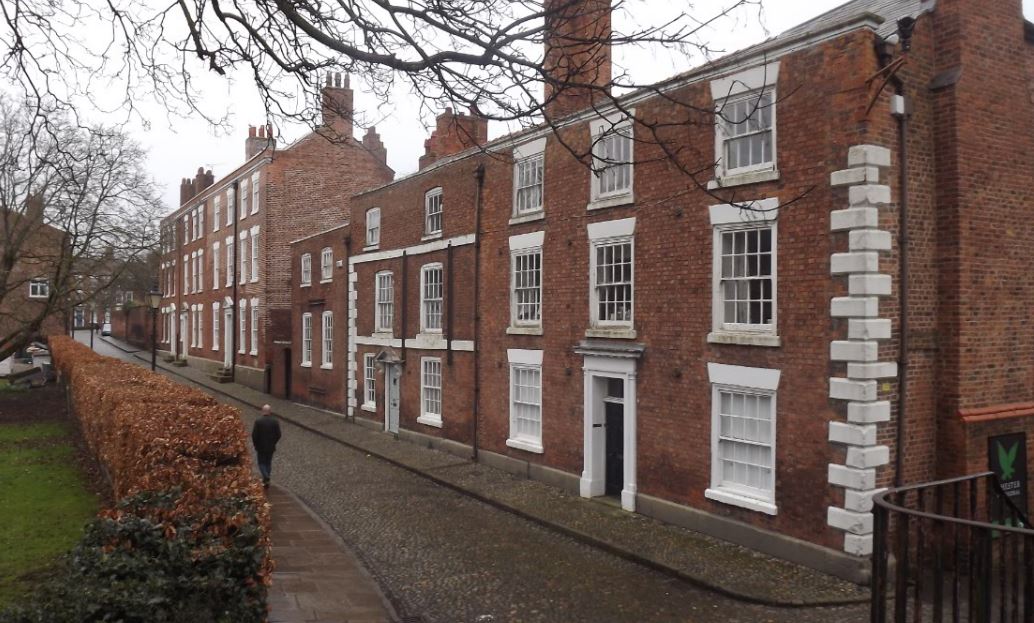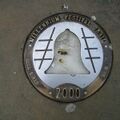Abbey Street
Anyone walking down Abbey Street might think they were walking on medieval "river-bed" cobbles. Actually, the cobble-stones were laid during restoration work in 1980 following the Historic Towns Report "Chester: a study in Conservation", published by Sir Donald Insall in 1968.

The Bishops House was originally the Deanery. Probably dating to mid C18, it has been added to and altered. It is built in Flemish bond brown brick with a Westmorland green slate roof.
Abbey Chambers is a detached town house, from 1754. Built on a probably 40-year lease from the Dean and Chapter of Chester Cathedral. A fragment of a probably pre C18 wall of coursed rubble sandstone is attached to the rear. In the early 19th century when the gaol yard was added, it necessitated the demolition of the section of the wall that included the Shipgate. It was taken down on April 12th 1831. Each stone was numbered and the Shipgate moved to the garden of Mr John Finchett-Maddock, the Town Clerk (1817-57), at "Abbey Chambers". Finchett-Maddock was also MP for Chester. However, the Shipgate was not to stay put. In May 1893 another Finchett-Maddock gave it to the Chester Archaeological Society and it was for a while hoped that it could be moved back to its original location. This proved impractical and the Shipgate was re-errected by the Corporation in August 1897 in the Groves, and finally, moved in 1923 to the southwestern corner of Grosvenor Park where it still stands today.
Nos 4-10 are a row of 4 small town houses. 1826-8. For Mr Thomas of King Street, Chester as sub-lessor of the prebendal land of Rev. James Thomas Law. Flemish bond brown brick with grey slate roof. Prebendary J. T. Law, resident at Nos 1 and 2 Abbey Square, engineered this development on land previously occupied by his stables, to the displeasure of the Dean and the majority of Chapter.
Nos. 5-9 are a terrace of 3 town houses. Nos 5 & 7 are dated 1764 on the top butterfly bracket. The houses were built by leaseholders from the Dean and Chapter of Chester Cathedral. The houses were renovated 1979-80.
No. 13 is a town house, c1720, with later addition and alterations. The rear of the main block has flush quoins to north-wes corner, a replaced tripartite sash to the first storey, with a Gothick tripartite sash to the second storey with 'intersecting tracery' glazing bars to each light.
No. 15 is a town house altered and added to early and late C18, by leaseholder from Dean and Chapter of Chester Cathedral. The east side has a Gothick-arched fixed light with 'intersecting tracery' glazing bars to second storey. In 1945 the Firs School first opened by Florence Longman, a New Zealander, in a small room in 15 Abbey Street, later moving to other premises.

The New Song School building of the Cathedral is best seen from Abbey Street. The project comprised the construction of new accommodation at first and second floor levels above the existing ground floor rooms, on the site of the old Monk’s Dormitory. Access is via a new lift and stair tower. The external walls are in red sandstone from the Locharbriggs Quarry in Dumfries and the roof is covered in Heather Blue natural slates from the Penrhyn Quarry in Bethesda, both to match the surrounding cathedral buildings.
An Abbey Street Gallery
..not the same "Nora Batty"
See the carving in the Wall which represents the length of the Great Eastern
1969 - the bells are removed from the Cathedral;
In February 1969, nine of the ten bells in the central tower were removed to be recast by John Taylor & Co as a ring of twelve bells with a flat sixth. The new bells were cast in 1973 and work on the new bell-tower began in the same year. Two old bells dating from 1606 and 1626 were left in the tower. On 26 February 1975 the new bells were rung for the first time, the official opening was on 25 June 1975. A now almost unique feature of the bell-tower is that the soffits above the door and windows are made of "lead coated steel" an innovation put into production at Chester's Leadworks. This was for cladding of buildings with rust free external panels and was a fore-runner to the cheaper plastics/aluminium panels which were used more recently (to disasterous effect due to flammability). The panels are manufactured by rolling together pre-treated steel sheet and lead sheet with sufficient force to ensure cohesion without the need for adhesive. The sandstone base of the tower is also of local origin while the slates are from Bethesda in North Wales.
The Saddlers and Curriers company originally had their own meeting place, the Saddler’s Tower on the city walls near the east end of Abbey Street. This is believed to have been a square watch tower, shown on a map of 1745, which stood (according to some) c. 50 m. north of the Kaleyards Gate and was aligned with the medieval defences, which stood 1.5 m. inside the Roman ones, the tower was built at a point where the Roman walls had collapsed or had been "robbed-out".
The Saddlers' company occupied their tower in the mid 16th century, and was still their meeting house in the later 17th. In 1690 it was repaired and said to be 241 years old. The tower was taken down to the level of the walls in 1779–80 and demolished in 1828. It's location is said to be presently marked by buttress-like structures representing the stubs of its north and south walls.
Hemingways Map of 1829 shows the city at the time of the Civil War (c. 1640) and shows the Sadler's Tower very close to the Kaleyard Gate. Others claim it was 50 meters north of the Kaleyard gate. Hemingway writes of the Kaleyard Gate (postern):
- Near to the postern aforesaid we pass by on the right hand on the walls the remains of a watch tower usurlly called Sadler's tower because the company of sadlers obtained it from the city for a meeting house.
He adds as a note:
- Sadler's Tower stood exactly opposite the end of Abbey street but was taken down in the year 1779 There was an outward square projection the walls which marked the place where it stood but this also was enclosed within the wall in the year 1828).
John Seacome's Chester Guide, published shortly after 1828, tells us that, starting from the Kaleyard Gate:
- A few paces farther on was a quadrangular abutment on which formerly stood a tower called The Sadler's Tower from the Company of Sadlers holding their meetings there The tower was taken down in 1780 and the abutment being the occasion of a great nuisance to the residence of Griflith Rowlauds Esquire immediately opposite from the number of idle and disorderly characters who were in the habit of congregating there of an evening that gentleman obtained permission from the Corporation to take it down and continue the Wall at his own expense in February 1828
Pigot writes as follows:
- A little farther is a projection on which formerly stood a Tower where the Company of Saddlers used to meet this was taken down about the year 1780.
While not set in stone the location of the Sadler's Tower seems to have been quite close to the Kaleyard gate. Notably the historical records for July 1828 state that as a consequebce of a rainstorm a section of the City Walls near the site of Sadler's Tower collapses "with a terrible crash, the earth having been completely excavated and washed away by the descending torrents". One wonders if the collapse was in any way connected with Griflith Rowlauds.









